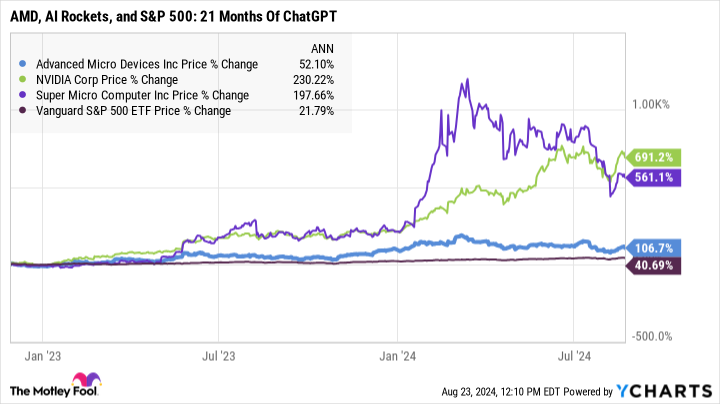AMD’s stock has gained 107% since the launch of ChatGPT, lagging behind Super Micro and Nvidia but outperforming the S&P 500.
Advanced Micro Devices (AMD 2.16%) has been a big winner in artificial intelligence (AI) boom. The chip designer’s stock has gained 107% since OpenAI launched the game-changing ChatGPT platform. While that price climb can’t compare to AI market darlings Nvidia (NVDA 4.55%) and Super Micro Computers (SMCI 1.39%), it’s a market-stomping performance.
Less than 30 stocks among the 503 members of the S&P 500 (^GSPC 1.15%) index have done better in this period, and the index itself “only” gained 41%. The index gain works out to a compound annual growth rate (CAGR) of 21.8%. If I could match that soaring speed over a full decade, I’d turn a $1,000 investment into a $7,200 return. And AMD is smoking that wealth-building S&P 500 return right now.
But that’s already old news. Past results are no guarantee of future success. The burning question existing and potential AMD investors should ask today is whether the stock has room to run any higher from this lofty perch.
How AMD’s Instinct AI accelerator chip stacks up against Nvidia
AMD is no spring chicken in the high-performance computing market. The AMD Instinct MI250X accelerator chip Is found in 10 systems on the latest list of the world’s 500 largest and most powerful supercomputers.
Nvidia dominates that system list, led by at least 48 systems using the V100 accelerator and more than 80 relying on some version of the A100 chip. But when you look at the performance numbers, the leading AMD chip with a 2% share of system counts delivers a staggering 21.4% of the entire list’s number-crunching performance.
The Instinct MI250X didn’t do it through unbeatable performance per chip. This achievement was built on massive installation numbers. The AMD Instinct systems have 12.7 million processor cores at work in those ten massive supercomputers, led by 8.7 million Instinct cores in the greatest performer of them all — the Frontier system at the Oak Ridge National Laboratory. The largest Nvidia-based systems stop around 2 million processor cores.
I apologize if that got a bit nerdy with processor details and big numbers. In short, a lot of cheaper chips can do the same job as a few expensive, top-of-the-line processors. I’m trying to make a simple point, though:
AMD’s AI accelerators are very competitive, especially if you include unit pricing. Throwing lots of lower-priced hardware at AI problems can make up for any edge Nvidia’s chips might have in terms of plain performance.
In other words, AMD may deserve a bigger slice of the AI market than it gets credit for today. CFO Jean Hu and CEO Lisa Su like to focus on the total cost of ownership (TCO) when comparing AMD’s products to Nvidia’s, and the company is already winning system deals from that angle. This concept includes chip prices, power consumption, support for more memory per chip, and other total system aspects that can outweigh Nvidia’s lead in pure performance per chip.
Is AMD’s price premium justified?
So AMD should be on your list of AI hardware providers to watch. Should it be your next buy in the AI space?
As it turns out, AMD’s stock might already have the market respect it deserves. As noted earlier, AMD’s stock chart makes the broader market look stale and stalled. Moreover, these shares are more richly valued than Nvidia’s in many ways:
|
Valuation Metric |
AMD |
Nvidia |
|---|---|---|
|
Price to earnings (P/E) |
183 |
72 |
|
Price to free cash flow (P/FCF) |
183 |
80 |
|
Enterprise value to earnings before interest and taxes (EV/EBIT) |
275 |
63 |
Data from Finviz and Morningstar, current as of 8/23/2024.
AMD’s shares are more affordable in terms of price to sales or the price to earnings to growth ratio, so it’s not a slam dunk in either direction. Still, it’s hard to call AMD’s stock “affordable” in any way, shape, or form.
Can AMD carve out a lucrative AI niche?
Longtime AMD investors should be used to uncomfortably high valuation ratios. This stock has a long history of soaring to lofty valuation ratios.
Due to AMD’s tendency toward low profit margins, the math gets a little bit absurd sometimes. P/FCF and P/E ratios were measured in the thousands in 2004,as the K2 line of PC processors put up a spirited fight against Intel‘s (INTC 2.19%) Celeron and Pentium 4 lineups. AMD stock was also more pricey than Nvidia’s from 2018 to 2021, when both companies had unexpected manufacturing advantages over a struggling Intel.
So the real question is, will AMD be able to carve out a lucrative niche for itself in this era of heavy AI interest?
I’m thinking that it can. Nothing seems impossible under the leadership of Lisa Su, who also seems to have a good handle on how to make the most of this game-changing moment. AMD isn’t trying to be Nvidia 2.0, but choosing a different path with significantly different plans and designs.
So the stock is expensive, but then it kind of always is. And I think there’s plenty of room for a different approach to AI computing from a company (or several) not named Nvidia. Check your risk tolerance before going any further, but AMD could be an interesting buy for growth investors who respect Lisa Su’s leadership.
Anders Bylund has positions in Intel and Nvidia. The Motley Fool has positions in and recommends Advanced Micro Devices and Nvidia. The Motley Fool recommends Intel and recommends the following options: short August 2024 $35 calls on Intel. The Motley Fool has a disclosure policy.







